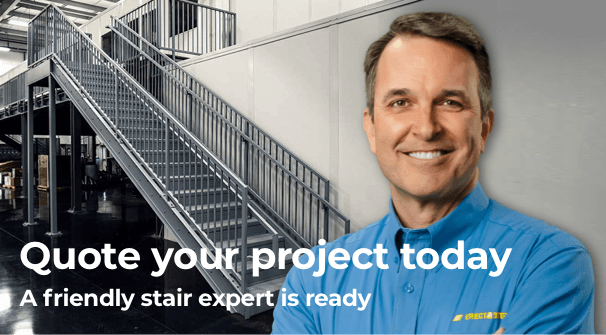Get a quote, configure a custom stair or ask a question. We're here to help!
Eliminate Ergonomic Hazards with Mobile Work Platforms
View All Featured InstallationsErgonomic hazards are always lurking, and it can happen at any time. Workers need mobile work platforms to eliminate these threats so they don’t get injured or become ill from an accident while on the job site.
A mobile work platform is a versatile piece of equipment that employees can use in optimal settings. Whether you need to reach high shelves in a warehouse or move heavy furniture around in a showroom, a mobile work platform can make the job simpler and safer. Work platforms can raise or lower workers to take an ergonomically-correct posture. The adjustability and portability allow workers to stay comfortable while working and help prevent neck and back pain. The maintenance work in any industrial environment requires a portable (while offering wheels for convenience) approach that facilities can tailor to each unique situation. Some of the benefits of using a mobile work platform include:
- Improved worker productivity: When workers can stand at the optimal working height, they can work more efficiently and with less fatigue.
- Reduced risk of injury: By eliminating the need to stoop, bend, or reach, mobile work platforms help reduce the risk of back injuries and other musculoskeletal disorders.
- Increased safety: Mobile work platforms offer increased stability and safety features, such as guardrails and non-slip surfaces, which can help prevent accidents.
Mobile work platforms are like specialized tools for every industry and task. These metal stairs and platform combo meet a wide range of uses, from construction sites or warehouse production lines down to office settings where employees frequently change functions on short notice without needing extra space–they’re just waiting around ready!
Taking advantage of body ergonomic knowledge in workplace safety can help prevent injuries and illnesses. Ergonomics is the study of how humans interact with their environment, which includes looking at what tools or equipment they have available as well as where those items are located on-site. The human body is designed to work comfortably in an upright position with minimal amounts of stress on the spine. Tasks that require bending, stooping, or hovering over long periods may cause back problems later down the line when individuals cannot keep themselves occupied during these hours due to their discomfort from being in a bad posture for so much time!
Non-fatal work injuries due to ergonomics-related factors are the fastest growing type of occupational health issue, accounting for 56-63% percent. The most recent statistics from US Bureau Of Labor Statistics show that ergonomic cases have increased by over 300% in just five years! This means there is one reported case every 3 days which comes to around 2 million annually across America alone.
The key takeaway is if you want healthier and able-bodied employees who aren’t distracted by pain, then make sure any assigned task has been ergonomically planned out and will allow them to maintain good posture without hurting themselves in the long run. Ergonomic hazards can be prevented by following some general safety tips. These precautions will help you avoid some of the most common ergonomic problems and their associated injuries:
- When you’re lifting heavy items, be knowledgeable about body limitations.
- Provide carts or wheeled equipment for transporting materials, so your employees don’t have to lift them independently.
- Make sure all loads are labeled with their weight using safety stickers.
- Generally, you should never twist or turn your spine while carrying the load.
- Assign two people to lift heavy objects depending on their weight so that one of them can take care not to hurt themselves with any sudden movements.
- To avoid fatigue, increase the number of workers on a shift when needed.
- Rotate tasks or implement shifts among workers to keep from doing the same thing in one area over again or having your employees do similar work for an extended period without ample rest.
- You can also use different schedules with shorter hours during weekdays versus weekends if you want more breaks from time spent working.
- To reduce the symptoms of fatigue, provide workers with enough time off to rest.
- Offer training on ergonomic policies and procedures.
- Work area should be kept clean and obstruction-free during each shift.
A mobile work platform may be the perfect solution if you want to improve worker productivity and safety in your facility. The standing and moving around can cause pain in the back, neck or joints. This is why it’s important to have good ergonomics when designing your facility and equipment so that employees don’t experience any discomfort while working for you!
By implementing ergonomics safety as part of the workplace culture, workers can benefit from having their capabilities and physical limitations matched with tools that will allow them to work in comfortable positions. Awareness about ergonomics ultimately leads to safer working conditions for all involved!










